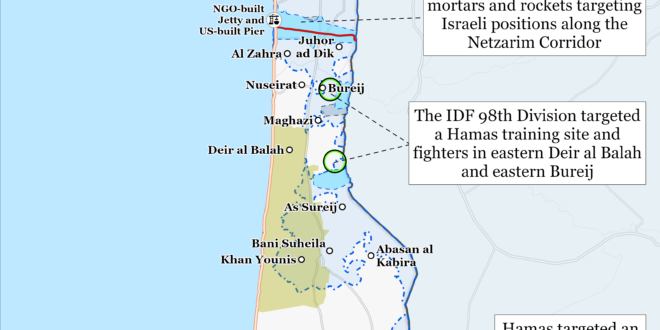The Iranian Guardian Council approved a pool of six candidates that included mostly hardliners for the upcoming 2024 presidential election. The six approved candidates include five hardliners and one reformist on June 9 for the upcoming presidential election.[i] The Iranian regime likely approved the sole reformist candidate to feign political diversity and therefore increase voter participation. Iranian officials have emphasized the need for ”competitive” and ”participatory” elections.[ii] Iran recorded record low voter turnout in its March 2024 parliamentary election, though the real voter turnout was likely even lower than the officially recorded turnout.[iii] The Guardian Council approved the following individuals to run for president:
- Mohammad Bagher Ghalibaf (Hardliner). Ghalibaf is a hardline politician who has served as Iran’s parliament speaker since 2020.[iv] Parliamentarians recently re-elected Ghalibaf as parliament speaker on May 28.[v] Ghalibaf is a long-time member of the Islamic Revolutionary Guards Corps (IRGC), having served as the IRGC Air Force commander between 1997 and 2000.[vi]He is a very well-connected politician who maintains close personal relationships with the highest echelons of the IRGC dating back to the Iran-Iraq War.[vii] Ghalibaf also served as Iran’s police chief between 2000 and 2005.[viii] This marks Ghalibaf’s fourth bid for the presidency.[ix]
- Saeed Jalili (Hardliner). Jalili is a hardline politician and diplomat who currently serves as a member of the Expediency Discernment Council.[x] Jalili previously served as the secretary of the Supreme National Security Council (SNSC) and chief nuclear negotiator from 2007 to 2013.[xi] Jalili currently serves as the Supreme Leader’s representative to the SNSC.[xii] This marks Jalili’s third bid for the presidency.[xiii]
- Amir Hossein Ghazi Zadeh Hashemi (Hardliner). Hashemi is a hardline politician who has served as vice president and the head of the Martyrs and Veterans Affairs Foundation in the Raisi administration from 2021 to the present.[xiv] Hashemi served as a representative for Mashhad in parliament from 2008 to 2021.[xv] Hashemi ran for president and lost in 2021.[xvi]
- Ali Reza Zakani (Hardliner). Zakani is a hardline politician who has served as the mayor of Tehran since 2021.[xvii] The Guardian Council barred Zakani from running in the 2013 and 2017 presidential elections.[xviii] Zakani competed in the 2021 presidential election but ultimately withdrew his candidacy in support of Raisi.[xix] Zakani previously headed the Student Basij Organization during the crackdown on student protesters in July 1999.[xx]
- Mostafa Pour Mohammadi (Hardliner). Pour Mohammadi is a hardline politician and cleric from Qom.[xxi] Pour Mohammadi served as the Justice Minister under President Hassan Rouhani from 2013 to 2017.[xxii] Pour Mohammadi notoriously served with former President Ebrahim Raisi on the 1988 ”Death Commission,” which approved the executions of thousands of political prisoners.[xxiii]
- Masoud Pezeshkian (Reformist): Pezeshkian is the sole reformist politician the Guardian Council permitted to run in the 2024 presidential election. Pezeshkian is an ethnic Azeri who has represented Tabriz, near the Iran-Azerbaijan border, from 2008 to present.[xxiv] Pezeshkian was initially disqualified from running in the 2024 parliamentary elections, but the Guardian Council later permitted him to run. Pezeshkian has criticized the Iranian government over the issue of hijab enforcement.[xxv] Pezeshkian announced that Mohammad Javad Zarif would serve as his foreign minister should he be elected president.[xxvi]
- The candidacy of five Iranian hardliners risks an electoral challenge for the hardline camp, wherein the hardline votes could be split amongst the five candidates. The hardline camp may split its votes amongst the five hardline candidates, which would benefit the sole reformist candidate.[xxvii] It is likely that some hardline candidates will withdraw from the election to prevent the vote from splitting. The moderate-reformist camp, by comparison, appears relatively united. Reform Front Spokesperson Javad Emam stated on June 8 that reformist politicians would not participate in the upcoming presidential election unless one of their candidates—including Masoud Pezeshkian—was approved.[xxviii] Multiple elements of the reformist camp expressed support for reformist candidate Masoud Pezeshkian on June 10.[xxix]
The Guardian Council did not approve the candidacy of some high-profile politicians, including former Parliament Speaker Ali Larijani and adviser to the supreme leader Vahid Haghanian.[xxx] The disqualification of Larijani illustrates the increased isolation of the once-prominent Larijani family from the regime.[xxxi] The Guardian Council also disqualified a close aide to supreme leader, Vahid Haghanian.[xxxii] The disqualification of Haghanian illustrates that the regime is going as far as to reject elements of its own government that it has trusted for decades. These disqualifications emphasize the regime’s commitment to engineering who will be the next president by limiting the pool of approved candidates.
Iranian Parliament Speaker Mohammad Bagher Ghalibaf’s advisers have spoken to Western diplomats in recent weeks, possibly to set conditions for the resumption of nuclear negotiations if he becomes president. An Iranian opposition outlet reported on June 10 that Ghalibaf’s advisers have talked to US and European diplomats over the past two weeks, citing an unspecified European diplomat.[xxxiii] The advisers have emphasized Ghalibaf’s willingness to “improve Iran’s relations with the rest of the world” and to “cleanse” the Iranian regime of “radical elements” during the advisers’ conversations with foreign officials.[xxxiv] The advisers have also emphasized that Ghalibaf would play a significant role in stabilizing the Iranian regime following Supreme Leader Ali Khamenei’s death.[xxxv] Ghalibaf is one of six candidates the Guardian Council approved to compete in the June 28 presidential election.[xxxvi] Ghalibaf is a pragmatic hardliner who has previously called for limited political and economic reforms within the framework of the Islamic Republic.[xxxvii] Ghalibaf may be trying to signal to Western governments that his administration would be more willing than the hardline Ebrahim Raisi administration to conduct nuclear negotiations and conclude a new nuclear deal.
Iranian-backed Iraqi militia Kataib Sayyid al Shuhada warned on June 8 that it will resume attacks targeting US forces if US forces do not leave Iraq.[xxxviii] Kataib Sayyid al Shuhada spokesperson Kazem al Fartousi told Iraqi media that the militia will “return to military actions” if ongoing negotiations between the United States and Iraq do not lead to the withdrawal of US forces from Iraq.[xxxix] The United States and Iraq began talks to evaluate the status of the US-led international coalition in late January 2024.[xl] A Lebanese Hezbollah–affiliated news outlet reported on May 25 that several Iranian-backed Iraqi militias believe the United States and Iraq have been “procrastinating” a decision to remove US forces from Iraq and are considering resuming attacks on US forces.[xli] Iraqi media recently reported on June 5 that unspecified Iranian-backed Iraqi militias plan to renew their attacks targeting US forces if Iraqi Prime Minister Mohammad Shia al Sudani does not set a deadline for a full US military withdrawal by July 15.[xlii]
An Israeli Army Radio correspondent highlighted some of the challenges that Israeli forces face intercepting drones targeting northern Israel in an X (Twitter) post on June 10.[xliii] The correspondent said that the drones are difficult for the IDF to intercept because of their short flight time from Lebanon to Israel. The close proximity between the drone launch sites and Israel makes it more difficult for the IDF to intercept the drones when compared to drone attacks against Israel from elsewhere in the Middle East. The long distance between Israel and Iran allowed Israel and its allies to detect and then intercept Iran’s incoming drones and missiles during Iran’s attack in April, for example.[xliv] The correspondent added that the drones launched from Lebanon fly low through challenging topography which makes them difficult to intercept.[xlv]
These challenges are particularly salient given the increased risk of a major war between Israel and Hezbollah in northern Israel. Hezbollah would likely use the lessons it is learning in its attacks on Israel to penetrate Israeli air defenses and strike critical infrastructure and civilian areas, including Haifa port. Hezbollah more than doubled its drone attacks targeting Israel between April and May 2024, though the group has used its drones to target Israel since the war began in October 2023.[xlvi] The correspondent said that the IDF plans to place 20mm Vulcan cannons in several areas along the Israel-Lebanon border to counter the drones.[xlvii]
Key Takeaways:
- Iranian Presidential Elections: The Iranian Guardian Council approved six candidates including one reformist and five hardliners for the upcoming 2024 presidential election. The participation of five hardliners risks splitting the hardline vote, though some hardliners will probably withdraw from the election to prevent splitting the vote. The Guardian Council did not approve some top politicians, including former Parliament Speaker Ali Larijani.
- Iran: Iranian Parliament Speaker Mohammad Bagher Ghalibaf’s advisers have spoken to Western diplomats in recent weeks, possibly to set conditions for the resumption of nuclear negotiations if he becomes president.
- Iraq: An Iranian-backed Iraqi militia warned on June 8 that it will resume attacks targeting US forces if US forces do not leave Iraq. Unspecified Iranian-backed militias in Iraq reportedly plan to renew attacks if the Iraqi prime minister does not set a deadline for a full US military withdrawal by May 15.
- Lebanon: An Israeli Army Radio correspondent highlighted some of the challenges that Israeli forces face intercepting drones targeting northern Israel in an X (Twitter) post on June 10. These challenges are particularly salient given the increased risk of a major war between Israel and Hezbollah in northern Israel. Hezbollah would likely use the lessons it is learning in its attacks on Israel to penetrate Israeli air defenses and strike critical infrastructure and civilian areas, including Haifa port.
- Ceasefire Negotiations: The United States is reportedly considering bilateral hostage talks with Hamas to free Americans from the Gaza Strip.
- Gaza Strip: Hamas leader in the Gaza Strip Yahya Sinwar is likely hiding in a “vast” tunnel system beneath Khan Younis, according to unspecified US officials speaking to the New York Times.
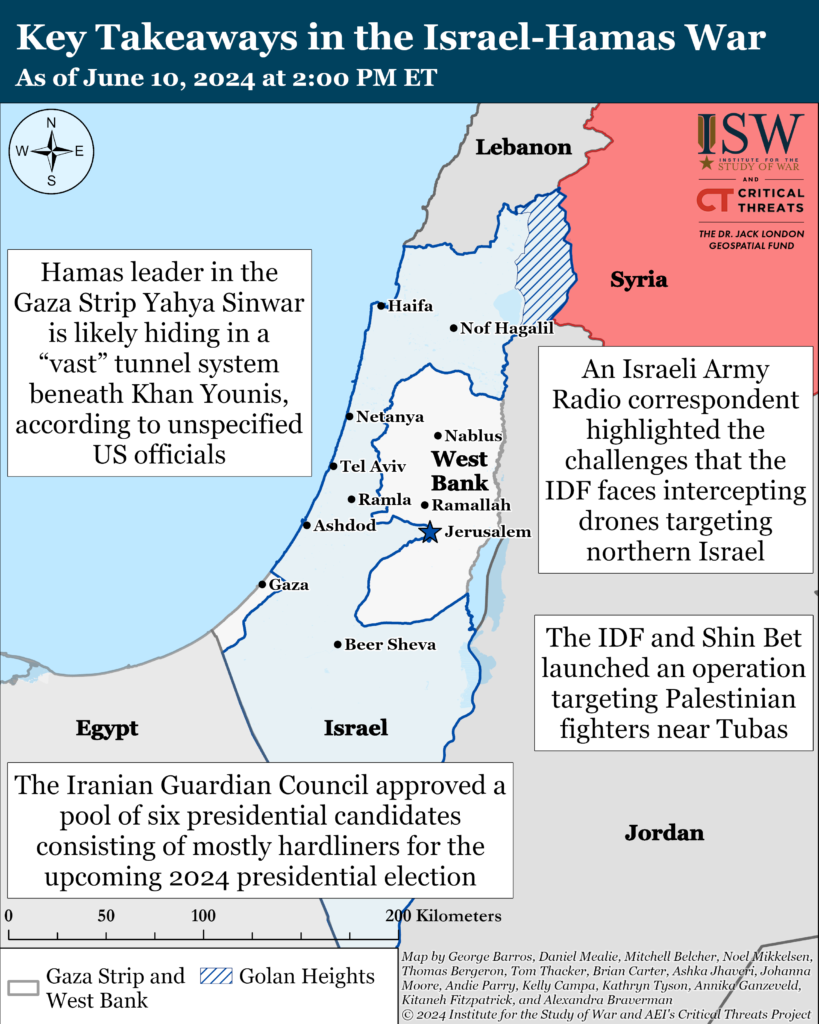
Gaza Strip
Axis of Resistance objectives:
Erode the will of the Israeli political establishment and public to sustain clearing operations in the Gaza Strip
Reestablish Hamas as the governing authority in the Gaza Strip
Palestinian fighters targeted Israel Defense Force (IDF) positions along the Netzarim Corridor in southern Gaza City on June 10. Palestinian fighters conducted at least five mortar and rocket attacks targeting Israeli “supply lines” and headquarters along the corridor.[xlviii] The IDF 99th Division is currently operating along the Netzarim Corridor. The IDF uses the corridor to launch raids against Hamas fighters and infrastructure in the northern and central Gaza Strip.[xlix]
The IDF 98th Division continued clearing operations in eastern Deir al Balah and eastern Bureij in the central Gaza Strip on June 10.[l] The IDF 98th Division and Southern Command directed strikes targeting Hamas Nukhba fighters and underground infrastructure in Deir al Balah.[li] The IDF 7th Brigade and the Yahalom combat engineering unit raided and subsequently destroyed underground militia infrastructure in eastern Bureij.[lii] The IDF 7th Brigade also destroyed a Hamas training compound.[liii] The IDF Kfir Brigade detained Palestinian fighters and located weapons caches in the central Gaza Strip.[liv] A battalion under the command of the IDF 35th Paratroopers Brigade engaged a Palestinian fighter emerging from a tunnel shaft carrying rocket-propelled grenade.[lv] Palestinian militias did not claim attacks targeting Israeli forces in Deir al Balah or Bureij on June 10.
The IDF 162nd Division continued clearing operations in Rafah on June 10. The IDF 401st Brigade directed a strike on two armed Palestinian fighters approaching Israeli forces.[lvi] Hamas fighters detonated a five-story building rigged to explode and collapse on an IDF Givati Brigade unit in Shaboura refugee camp, central Rafah.[lvii] Hamas repeatedly mortared the explosion site after the attack to prevent the Israeli quick reaction force from responding to the situation.[lviii] Palestinian reports claimed that the house-borne IED attack injured as many as 10 Israeli soldiers.[lix] The IDF has not commented on the incident at the time of writing. Hamas has inflicted high casualties on Israeli units through house-borne IED attacks, either by rigging the houses themselves or prematurely detonating buildings that Israeli forces rigged with explosives. The highest IDF single casualty event of the war, which killed 21 Israeli soldiers, occurred in January 2024 when Hamas detonated a building that the IDF had prepared to demolish with explosives in the central Gaza Strip.[lx] Palestinian militias claimed additional attacks in several sectors of Rafah, including western Rafah.[lxi]
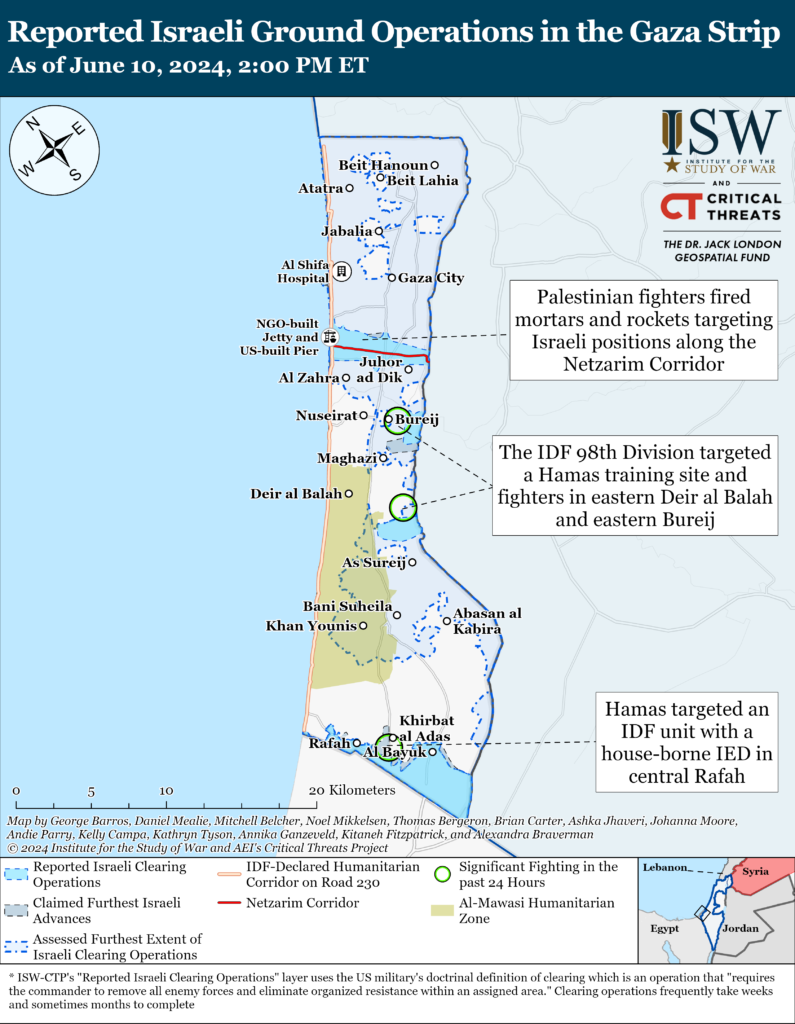
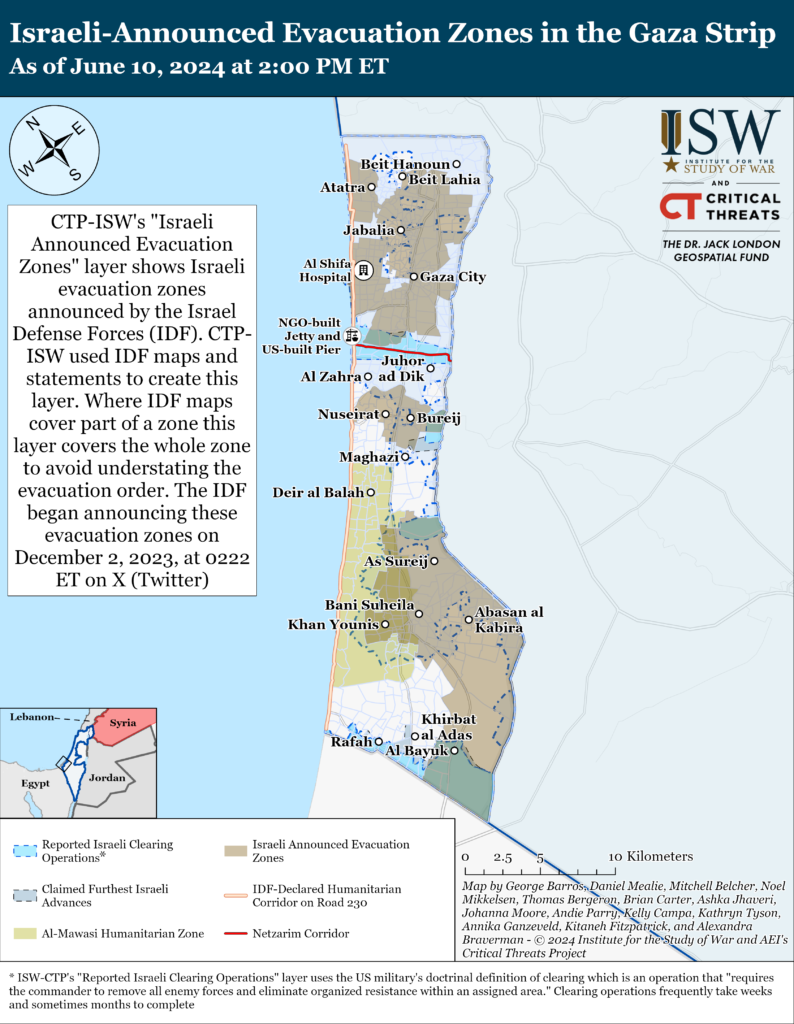
IDF 143rd (Gaza) Division Commander Brig. Gen. Avi Rosenfeld resigned from the IDF on June 9.[lxii] Rosenfeld will stay in his position until his replacement can assume the position.[lxiii] Rosenfeld said that he resigned because of his failure to protect Israeli communities along the Gaza Strip during the October 7 attack.[lxiv]
The United States may pursue bilateral hostage talks with Hamas to free Americans from the Gaza Strip, according to US officials speaking to NBC News.[lxv] Current and former US officials indicated that negotiations would only begin talks if the current Israeli ceasefire proposal fails. White House national security adviser Jake Sullivan confirmed on June 9 that the US is still waiting on the “official” Hamas response.[lxvi] Hamas officials have repeatedly indicated opposition to the latest Israeli ceasefire proposal.[lxvii] Qatar would facilitate the bilateral US-Hamas talks without Israeli officials.[lxviii]
CTP-ISW has previously noted that Hamas seems unlikely to accept a proposal that does not meet its maximalist demands, which include a permanent ceasefire, the complete withdrawal of Israeli forces from the Gaza Strip, and a hostage-for-prisoner exchange.[lxix] Hamas likely remains confident that it will survive Israeli military operations in the Gaza Strip and can therefore maintain its maximalist demands without granting major concessions.
Hamas Political Bureau Chairman Ismail Haniyeh and Palestinian Islamic Jihad (PIJ) Secretary General Ziyad al Nakhalah discussed ceasefire demands in Doha, Qatar, on June 10.[lxx] The Hamas and PIJ political leaders reiterated that the Palestinian factions are committed to Hamas’ maximalist ceasefire demands, including a permanent end to the war and a complete IDF withdrawal from the Gaza Strip.
Hamas leaders have given standing orders to Hamas fighters to shoot hostages if the fighters believe that Israeli forces are closing in, according to Israeli officials speaking to the New York Times.[lxxi] Hamas claimed on June 9 that the IDF operation to rescue four hostages in the central Gaza Strip on June 8 lead to the deaths of three other Israeli hostages.[lxxii] Hamas also threatened that Israel would not free any additional hostages unless Israel secured an exchange and ceasefire deal with Hamas.[lxxiii]
Hamas leader in the Gaza Strip Yahya Sinwar is likely hiding in a “vast” tunnel system beneath Khan Younis, according to unspecified US officials speaking to the New York Times.[lxxiv] The officials indicated that Sinwar was sheltering in Rafah before IDF clearing operations began there.[lxxv] CTP-ISW previously assessed that Palestinian fighters and senior leadership may be retreating from certain areas of the Gaza Strip during Israeli clearing operations there before reentering those areas after the Israelis depart.[lxxvi] Israeli forces are not permanently securing the areas that they clear, which allows Palestinian fighters to return after the IDF leaves. The Israeli military’s decision to withdraw from Khan Younis on April 6 meant that Hamas fighters and senior leaders could withdraw north when they came under Israeli pressure in Rafah.
The World Food Program (WFP) paused humanitarian aid provision through the US-built pier after recent rocket attacks near the pier. The organization’s director said that two of the WFP’s warehouses were struck by rocket fire. The attacks injured one individual on June 8.[lxxvii] The WFP expects to resume operations later this week, according to an informed source speaking to Axios.[lxxviii] US Central Command reattached its temporary pier off the coast of the Gaza Strip on June 7 after it suspended operations due to damage sustained at sea.[lxxix]
Palestinian militias have conducted at least one indirect fire attack from the Gaza Strip into southern Israel since CTP-ISW’s data cut off on June 9. PIJ launched mortars and rockets at an IDF site near Kerem Shalom.[lxxx]
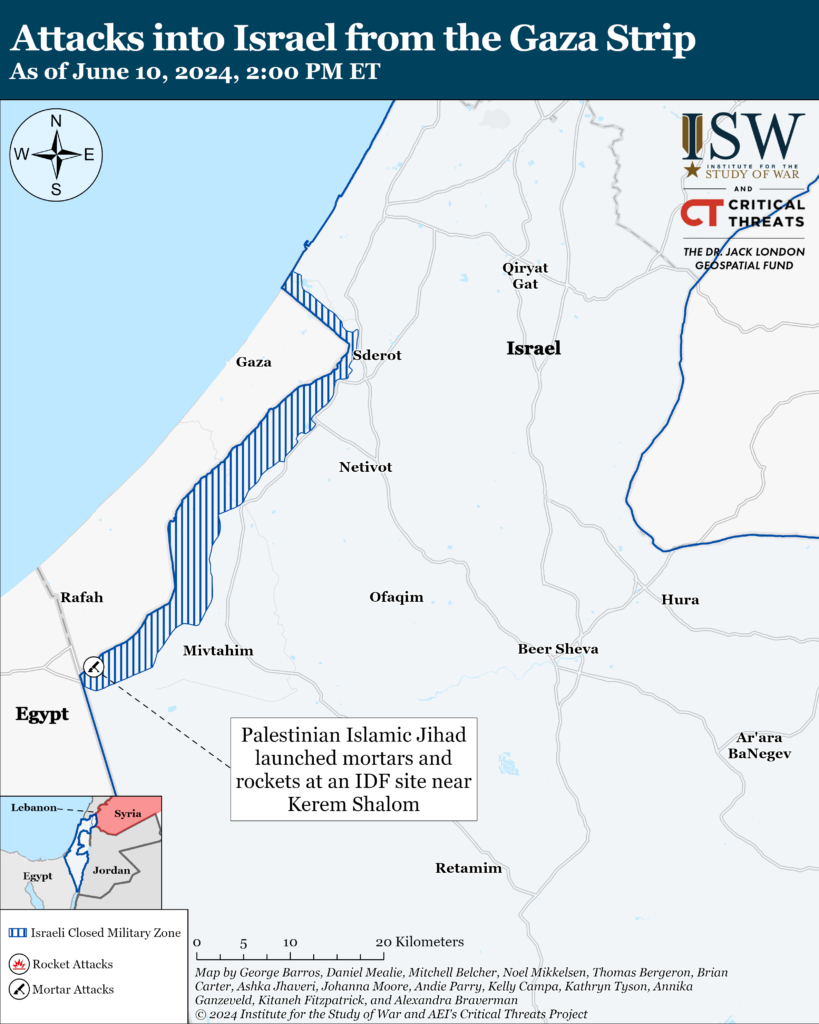
Recorded reports of attacks; CTP-ISW cannot independently verify impact.
West Bank
Axis of Resistance objectives:
Establish the West Bank as a viable front against Israel
Israeli forces have engaged Palestinian fighters in at least four locations across the West Bank since CTP-ISW’s last data cut off on June 9.[lxxxi] Unspecified fighters fired small arms and detonated improvised explosive devices (IED) targeting Israeli forces in Burqa, east of Ramallah.[lxxxii]
The IDF and Israeli Shin Bet launched an operation targeting Palestinian fighters near Tubas on June 10.[lxxxiii] The operation is ongoing at this time of writing. The IDF has detained three wanted individuals, destroyed explosives, and engaged fighters in the Faraa refugee camp.[lxxxiv] The al Aqsa Martyrs‘ Brigades fired small arms and detonated IEDs targeting Israeli forces in the camp.[lxxxv] Palestinian Authority-affiliated media reported that the IDF killed one Palestinian and wounded four others during the operation.[lxxxvi] Hamas mourned the death of one fighter in Tubas on June 10.[lxxxvii]
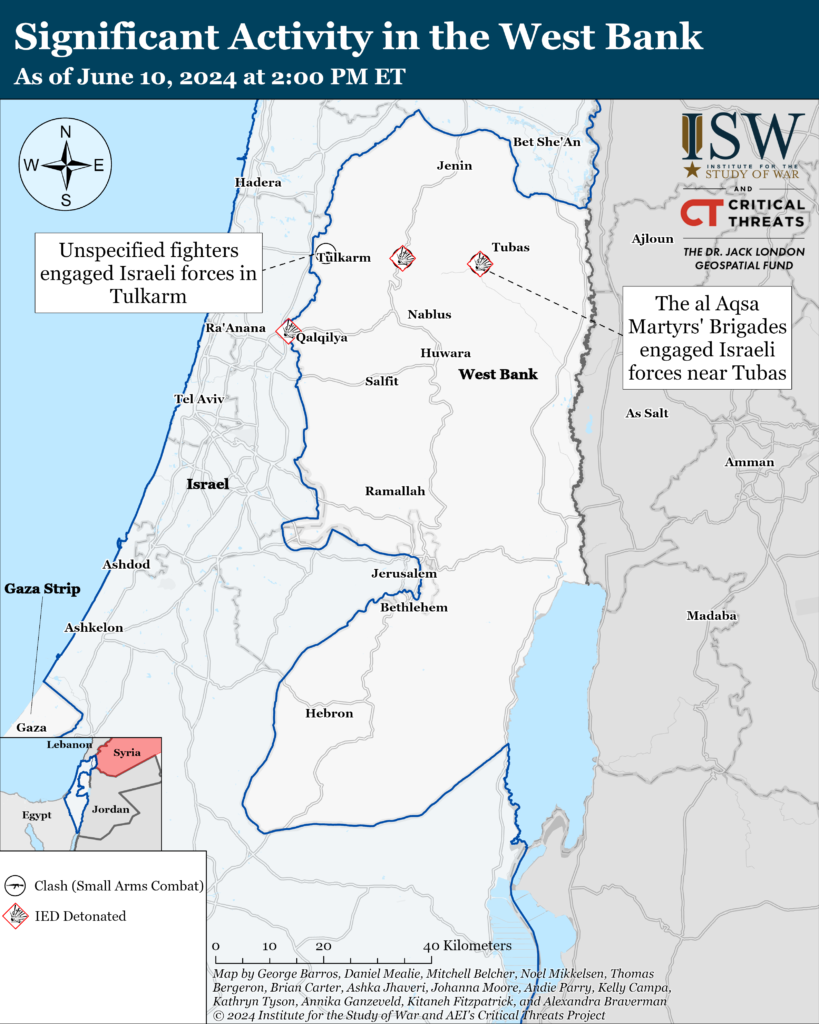
This map is not an exhaustive depiction of clashes and demonstrations in the West Bank.
Southern Lebanon and Golan Heights
Axis of Resistance objectives:
Deter Israel from cond
ADD NOTE
TWEET
ucting a ground operation into Lebanon
Prepare for an expanded and protracted conflict with Israel in the near term
Expel the United States from Syria
Iranian-backed militias, including Lebanese Hezbollah, have conducted at least 16 attacks into northern Israel since CTP-ISW’s last data cutoff on June 9.[lxxxviii] Hezbollah claimed three drone attacks targeting Israeli forces in northern Israel on June 10.[lxxxix]
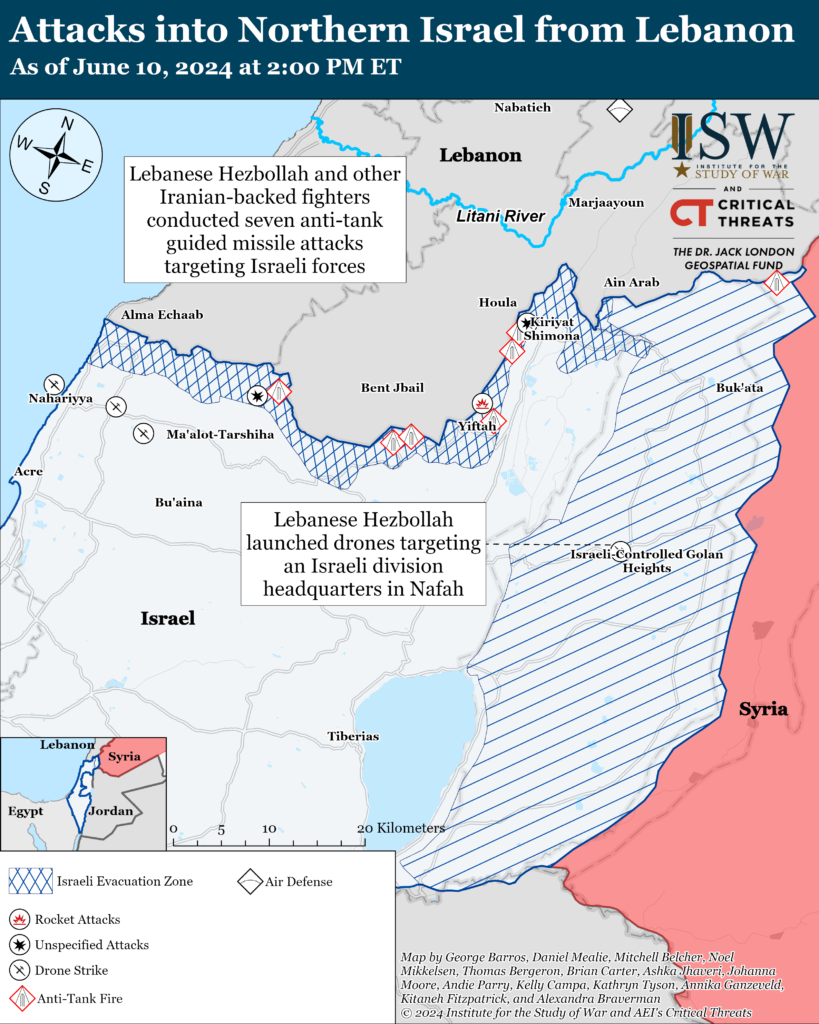
Recorded reports of attacks; CTP-ISW cannot independently verify impact.
Iran and Axis of Resistance
US Central Command (CENTCOM) destroyed two Houthi land attack cruise missiles and one missile launcher in Houthi-controlled territory in Yemen on June 9.[xc] Houthi media claimed that the United States and the United Kingdom conducted three airstrikes targeting al Jabaneh, west of Hudaydah, Yemen, on June 9.[xci] CENTCOM also intercepted a Houthi one-way attack drone over the Gulf of Aden on June 9.[xcii]
Iraqi militia Ansar al Marjaiya (44th Popular Mobilization Forces Brigade) Commander Hamid al Yasiri postponed anti-corruption demonstrations scheduled to take place in Samawah, Muthanna Province, on June 12. Yasiri originally called on June 7 for widespread demonstrations to “expel corrupt officials from [Muthanna] Province and its council.”[xciii] Yasiri also called on Iraqi Prime Minister Mohammad Shia al Sudani to install a “military governor” to govern the province.[xciv] Sudani emphasized that “criticism of corruption” must take place legally and within the framework of the Iraqi constitution during a meeting with Yasiri on June 9.[xcv] Sudani and Yasiri agreed on the formation of a committee headed by Federal Integrity Commission Chairman Haider Hanoun to investigate corruption and the waste of public funds in Samawah.[xcvi] Haider Hanoun is affiliated with the Iranian-backed Badr Organization.[xcvii] Yasiri announced the postponement of the demonstrations following his meeting with Sudani.[xcviii] The Muthanna Provincial Council elected Muhanna al Attabi as governor in February 2024.[xcix] Attabi reportedly has ties to former Prime Minister Nouri al Maliki’s State of Law Coalition.[c]
Acting Iranian Foreign Affairs Minister Ali Bagheri Kani held separate meetings with Russian presidential aide Igor Levitin and Chinese Foreign Affairs Minister Wang Yi on the sidelines of a BRICS foreign ministers conference in Nizhny Novgorod, Russia, on June 10.[ci] Bagheri Kani called for accelerating the construction of the Rasht-Astara railway during his meeting with Levitin.[cii] Bagheri Kani separately claimed that Iran and China are leading the way toward a multilateral world order during his meeting with Wang Yi.[ciii]
 Eurasia Press & News
Eurasia Press & News
